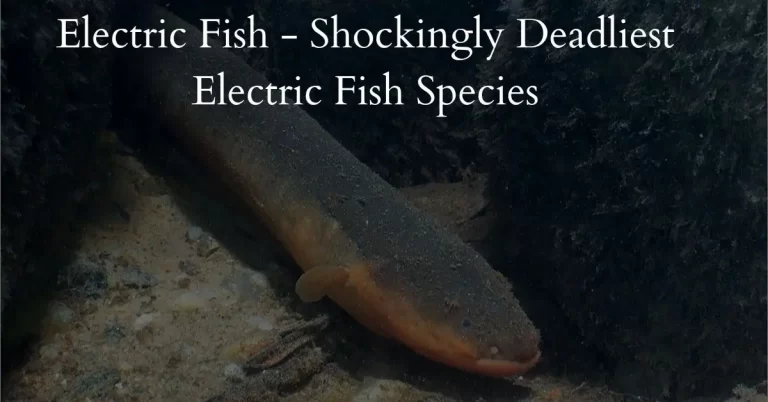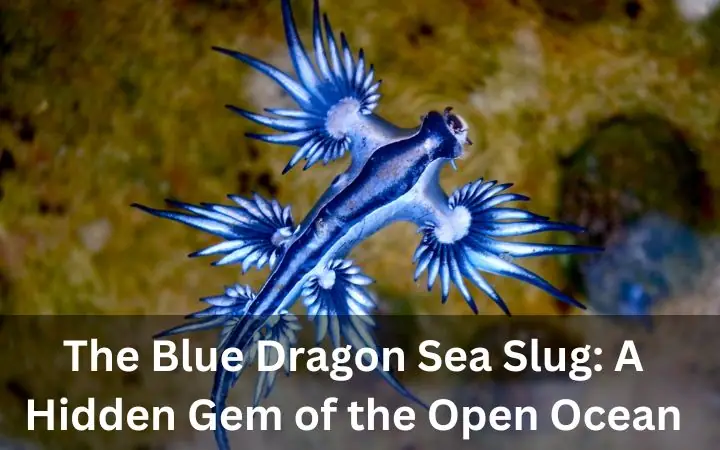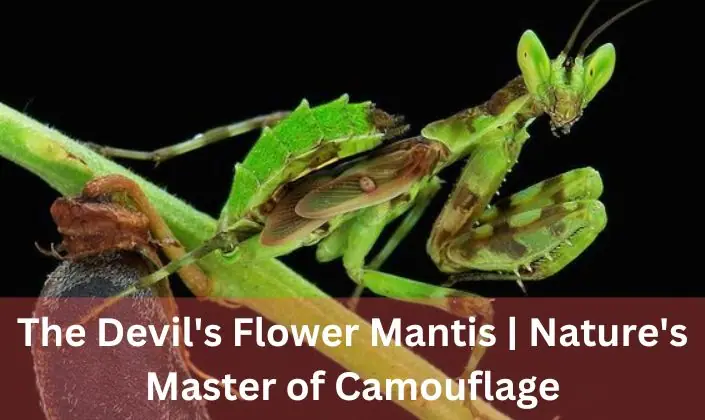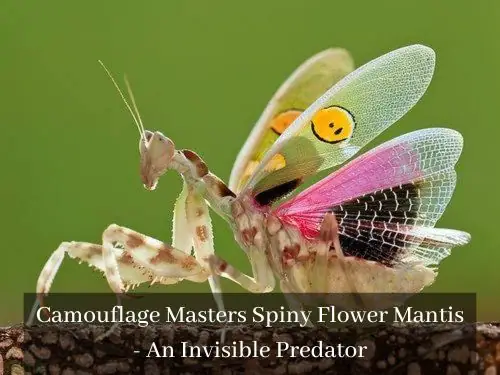The Orchid Mantis: Nature’s Living Flower

The Orchid Mantis, also known by its scientific name Hymenopus coronatus, is a fascinating creature that captivates both scientists and nature enthusiasts alike. With its stunning beauty and unique physical appearance, this remarkable insect has earned its place in the spotlight.
In this blog post, we’ll examine the Orchid Mantis’ many facets, including its physical traits, adaptations, hunting strategies, life cycle, and ecological importance. We will also talk about the difficulties in conserving it and the efforts being taken to safeguard this amazing species.
All About Orchid Mantis
Scientific Name and Classification
Scientific Name: Hymenopus coronatus Kingdom: Animalia Phylum: Arthropoda Class: Insecta Order: Mantodea Family: Hymenopodidae Genus: Hymenopus Species: coronatus
The Orchid Mantis is classified within the mantises, a group of insects known for their predatory nature and distinctive forelegs adapted for capturing prey.
.
Overview
The orchid mantis is a peaceful type of praying mantis that belongs to the family Hymenopodidae. It is renowned for its unique appearance and remarkable camouflage abilities. The orchid mantis is predominantly found in Southeast Asian countries such as Malaysia, Indonesia, and Thailand.
The distinctive feature of the orchid mantis is its extraordinary resemblance to a flower, particularly an orchid, hence its common name. It has evolved to mimic the appearance and colors of orchid petals in order to attract prey. The mantis typically exhibits hues of white, pink, or light green, which aid in its camouflage among the blossoms.
.
Physical Appearance
The orchid mantis is a visually striking insect with a unique physical appearance. Its slender body is adorned with a combination of vibrant colors, ranging from pure white to soft shades of pink or light green. These colors help the praying mantis blend seamlessly with the petals of orchid flowers, enabling it to ambush unsuspecting prey.
Its body structure is elongated and twig-like, mimicking the shape of a stick or branch. This clever adaptation allows the mantis to remain inconspicuous among foliage and further enhances its camouflage.
The mantis’s delicate wings are a notable feature, particularly in females. They are broad and elongated, showcasing intricate patterns and markings reminiscent of orchid petals. These translucent wings aid in the mantis’s disguise, providing an additional layer of camouflage when at rest or during slow movements. Its legs are long and slender, perfectly suited for grasping onto prey.
The forelegs are equipped with sharp spikes and bristles, which the mantis swiftly deploys to capture and immobilize its victims. With its triangular-shaped head, large compound eyes, and agile movements, the orchid praying mantis embodies an exquisite blend of beauty and adaptability in the insect kingdom.
.
Adaptations and Behavior
The orchid mantis has several remarkable adaptations and exhibits interesting behaviors that contribute to its survival and hunting success. These aspects are explained below:
1. Camouflage Adaptation
The primary adaptation of the orchid mantis is its extraordinary camouflage. Through its body shape, coloration, and behavior, it closely resembles a flower, specifically an orchid. This remarkable disguise allows the mantis to blend seamlessly with its surroundings, making it nearly indistinguishable from the petals of the flowers.
By appearing as an attractive floral display, the mantis can ambush unsuspecting prey that visit the flowers. Its patient sit-and-wait hunting strategy, combined with its remarkable camouflage, gives it a significant advantage in capturing insects like bees, butterflies, and other small arthropods.
2. Molting and Growth
Like other insects, the orchid mantis undergoes molting, a process in which it sheds its exoskeleton to facilitate growth. Molting allows the mantis to replace its outer covering as it grows and develops.
During molting, the mantis temporarily becomes vulnerable and may exhibit subdued colors until its new exoskeleton hardens. As it matures, the mantis gradually acquires its adult coloration and develops its unique appearance.
The molting process is crucial for the mantis to reach its full size and reproductive maturity. Orchid mantises may undergo several molts throughout their lifespan, with each molt representing a stage of growth and development.
These adaptations and behaviors, particularly the remarkable camouflage and hunting strategy, make the orchid mantis a fascinating and successful predator in its natural habitat. By blending in with its floral surroundings, it is able to deceive and capture unsuspecting prey, ensuring its survival in the intricate web of the ecosystem.
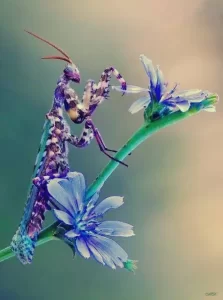
.
Habitat and Distribution
The orchid mantis is primarily found in the tropical regions of Southeast Asia. It is native to countries such as Malaysia, Indonesia, Thailand, and parts of neighboring regions. Within these areas, the mantis inhabits various types of tropical habitats, including rainforests, lowland forests, and coastal areas. It prefers locations with abundant vegetation, where it can effectively camouflage itself among the foliage and flowers.
The specific habitat within these regions where orchid mantises can be found is often associated with the presence of orchid flowers. These mantises are typically discovered in close proximity to orchid patches or other flowering plants. They rely on their remarkable camouflage to blend in seamlessly with the flowers and foliage, allowing them to patiently wait for unsuspecting prey to approach.
While the orchid mantis has a relatively limited distribution, it has gained attention and popularity worldwide due to its stunning appearance and unique adaptation.
.
Diet
The diet of orchid mantises is primarily carnivorous, as they obtain their nutrition exclusively from consuming other insects. They have evolved to be adept predators, taking advantage of the abundance of insect prey found in their habitats.These insects are drawn to the flowers for nectar or as potential pollinators, unaware of the lurking predator nearby.
When an unsuspecting insect ventures too close, the orchid mantis swiftly strikes with its spiked forelegs, capturing and immobilizing the prey. They rely on their quick reflexes, agility, and precise movements to secure their meals.
By targeting these specific prey species, these mantises exploit a niche in their ecosystem and showcase their specialized adaptations for successful predation.
.
Hunting Techniques and Prey
Orchid mantises employ stealthy hunting techniques and primarily prey upon various insects, especially those that are attracted to flowers. Here are describing their hunting techniques and prey:
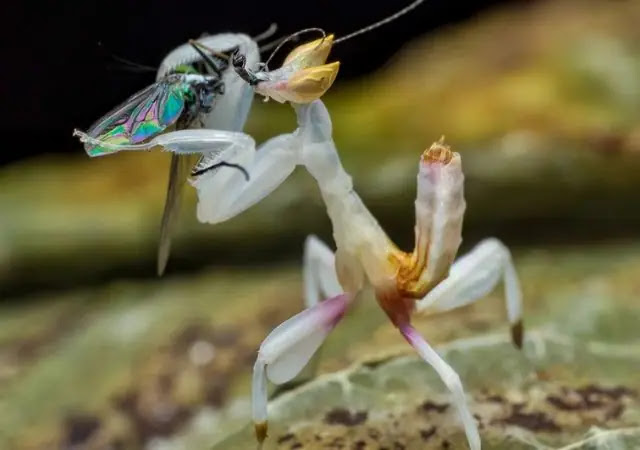
Hunting Techniques
Orchid mantises are sit-and-wait predators, strategically positioning themselves on flowers or foliage that closely resemble their appearance. They remain motionless, utilizing their exceptional camouflage to blend seamlessly into their surroundings.
With their bodies resembling orchid petals, they deceive unsuspecting insects into thinking they are approaching a flower. When an insect, such as a bee or butterfly, ventures too close, the mantis strikes with lightning speed.
Using their spiky forelegs, they grasp and immobilize their prey, ensuring a successful capture. Their agile movements and precise strikes make them formidable ambush predators.
Prey
The primary prey of orchid mantises consists of a variety of insects that are attracted to flowers for feeding or pollination purposes. They commonly target insects such as bees, butterflies, moths, flies, and other small arthropods.
Orchid mantises are particularly adapted to mimic the appearance and behaviors of these flower visitors, luring them in close range for an ambush. Their deceptive camouflage, combined with their sharp forelegs, enables them to successfully capture their unsuspecting prey.
By focusing on insects that frequent flowers, these mantises exploit a niche and take advantage of the abundance of potential prey in their habitat.
The hunting techniques of orchid mantises, coupled with their specific preference for insects attracted to flowers, showcase their specialized adaptations for successful predation. Their remarkable camouflage and precise strikes make them efficient and elusive predators in their natural environment.
.
Life Cycle and Reproduction
The life cycle and reproduction of the orchid mantis encompass several stages and fascinating behaviors. Here’s aspects are explained below:
Life Cycle
The life cycle of an orchid mantis starts with the mating process. Male mantises typically initiate courtship by approaching a receptive female and engaging in specific courtship behaviors, such as gentle tapping or waving their antennae. If the female accepts the male’s advances, mating occurs.
After mating, the female will lay her eggs, usually on plant stems or leaves. The eggs are enclosed in a protective case called an ootheca. The ootheca provides shelter and safeguards the developing eggs from predators and environmental conditions.
Within the ootheca, the eggs undergo a period of incubation, where they develop and eventually hatch into nymphs. The nymphs are miniature versions of the adults and undergo a series of molts as they grow and mature into adult mantises.
Reproduction
Orchid mantises exhibit sexual dimorphism, with females being larger and more robust than males. Once a male locates a receptive female, courtship rituals begin, usually involving gentle tapping or stroking behaviors to gain the female’s acceptance. Mating occurs when the female is receptive and willing to mate.
After mating, the female will produce an ootheca containing a cluster of eggs. Depending on the species and individual, the quantity of eggs produced might change, often ranging from dozens to hundreds. The female carefully attaches the ootheca to a suitable substrate, such as a plant stem or leaf, ensuring it is well-hidden and protected.
The ootheca offers a secure habitat for the development of the eggs, and after a time of incubation, the nymphs will break the surface of the eggs. The mantis offspring then continue their growth and development through a series of molts, gradually reaching their adult form and size.
It’s important to note that specific details of the life cycle and reproductive behaviors of orchid mantises can vary between species. However, the general pattern involves mating, egg-laying, incubation, hatching of nymphs, and subsequent growth and molting until adulthood.
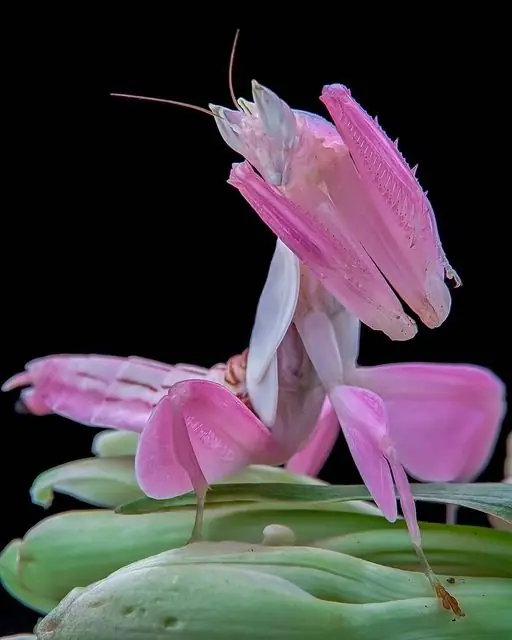
.
Conservation Status and Threats
The International Union for Conservation of Nature (IUCN) does not evaluate the orchid mantis’ conservation status on an individual basis. However, it’s critical to take into account the larger context of its habitat and any possible dangers.
Orchid mantis can be found in several tropical areas of Southeast Asia, however these areas are losing and degrading their habitat because of things like deforestation, increased agricultural production, and urbanisation. These activities can directly impact the mantis by reducing its available habitat and disrupting the delicate ecological balance it relies upon.
Furthermore, the collection of these mantises for the exotic pet trade poses another potential threat. Increased demand from collectors may lead to overharvesting and unsustainable removal of individuals from the wild. This can have negative consequences for the mantis populations, especially if proper regulations and conservation measures are not in place.
It is essential to encourage sustainable land management practises, protect and restore natural habitats, and increase understanding of the value of preserving biodiversity in order to ensure the conservation of orchid mantises and their habitats. Additionally, implementing measures to regulate and monitor the collection and trade of these insects is essential to prevent overexploitation.
.
Conclusion
The Orchid Mantis, with its exquisite beauty and remarkable adaptations, is a truly captivating creature. From its stunning floral mimicry to its stealthy hunting techniques, this insect showcases the wonders of nature’s design. Its role as a predator and its impact on pest control contribute to the delicate balance of the ecosystem.
Not only does the orchid praying mantis serve as a beneficial insect, but it also holds cultural significance and captivates the imagination with its mythology and symbolism. Its popularity as a pet highlights its appeal and the fascination it elicits from enthusiasts.
FAQs:
How long do orchid mantis live?
The lifespan of an Orchid Mantis varies depending on several factors, including environmental conditions and individual circumstances. Generally, the average lifespan for an adult Orchid Mantis is around 6 to 9 months. However, there can be variations, with some individuals living shorter or longer lives. Males typically have a shorter lifespan compared to females, often living for only a few months after reaching adulthood.
Where do orchid mantis live?
Orchid Mantises are native to Southeast Asia, specifically found in countries such as Malaysia, Indonesia, and Thailand. They inhabit various types of habitats within these regions, including rainforests, gardens, and tropical areas with abundant vegetation.
What do orchid mantis eat?
Orchid Mantises primarily feed on smaller insects, such as butterflies, moths, bees, and flies. They are opportunistic predators and will consume various other insects that come within their range.
Read Also:
- Camouflage Masters Spiny Flower Mantis – An Invisible Predator
- The Devil’s Flower Mantis | Nature’s Master of Camouflage

